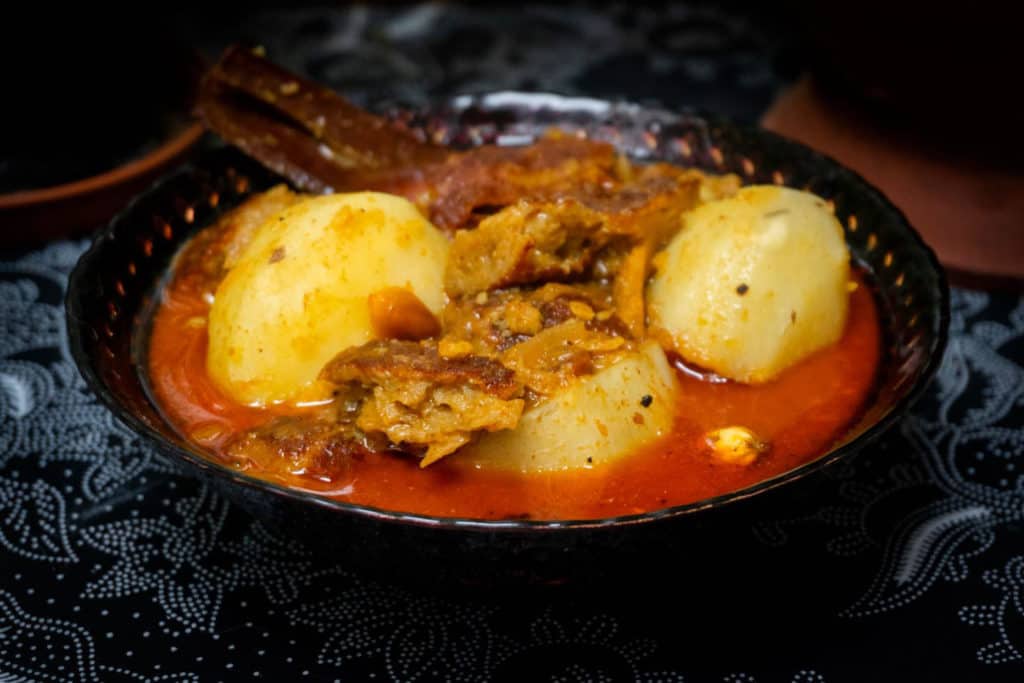I've been giving thought to including more recipes for familiar vegan Thai dishes and began by making a list of curries people might like to see. Massaman curry topped the list. But then I went and found a more obscure interpretation of the dish and so I've landed you with an atypical (outside of Thailand) recipe for vegan massaman curry instead. Go figure.

Thai massaman curry is a less a homogeneous dish than many would imagine. This is unsurprising given the ways any dish unfolds itself when we research it for five minutes (or weeks). The prevaling image of massaman is a thick and rich perfumed coconut curry that is mild in chilli spice and contains potatoes and peanuts. This image is of the central Thai rendition of massaman, but in this post I will offer a different kind of vegan massaman curry recipe with similar characteristics.
There are many interpretations of massaman curry, but they universally contain toasted spices of Indo-Persian origin. In the familiar central version described above, spices are pounded into a paste along with the usual characters of galangal, lemongrass, makrut lime zest, and shrimp paste familiar to us in other Thai curry pastes.
In the book Muslim Food, Nida Hongwiwat describes some of the differences between versions of massaman curry in Thailand. In Southern Muslim Thai versions of massaman, toasted and ground spices comprise a curry powder that is fried in oil along with onions or shallots. In Malay-Javanese massaman curries found within these Muslim communities, you might find more Chinese influence with day lilies and bamboo shoots as ingredients. These versions are also likely to be saltier, rather than sweet like central massaman.
The vegan massaman curry recipe I provide at the end of this post is based on a recipe and cooking methods from the aforementioned cookery volume.
Thai Muslims might refer to the dish as salaman or saraman (ซาละหมั่น). Uncertain why this is the case, I asked a Thai friend who better steeped in Thai food anthropology than me. Her thought is it's related to cari saraman, a Cham Muslim dish found in Cambodia. I pulled the book Ambarella: Cambodian Cuisine, from my shelf, and sure enough the authors describe cari saraman as the Cambodian version of massaman. Elsewhere, this Cham curry is compared to Malaysian rendang, a stew that also contains toasted coconut. This is also a relevant comparison with this Malay-Java style of massaman found in Southern Thailand, which also contains toasted fresh coconut.
📖 Recipe
Malaysian-Javanese style vegan massaman curry
Ingredients
- 250 millilitres coconut cream, divided see notes1
- 250 millilitres vegetable or other flavourless oil, divided
- 7 Thai cardamom pods or 5 green, pressed lightly with the back of a knife to crack open. See notes2
- 5 cloves
- 1 3-inch piece cinnamon
- ⅓ cup sliced shallot
- 1 ½ tablespoons minced garlic
- 1 ½ tablespoons toasted coconut see notes3
- 1 tablespoon minced ginger
- 2 ¼ teaspoons deggi mirch or other Indian chilli powder see notes4
- 1 ½ teaspoons ground coriander
- ½ teaspoon ground cumin
- ½ teaspoon ground white pepper black pepper or a mix is okay too
- ½ teaspoon ground turmeric
- 150 millilitres coconut milk see notes5
- 2 teaspoons salt
- 3 tablespoons palm sugar
- 200 grams potato peeled and boiled in salted water until fork tender, and cut into 1 inch chunks
- 1 ½ - 2 cups cooked seitan or fake chicken, tofu, etc...
- 2 tablespoons roasted peanuts
- 2-3 tablespoons tamarind water see notes6
Instructions
- Add all but about 125 millilitres (¼ cup) of the coconut cream as well as half of the oil to a medium saucepan (not a saute pan as you want to give some room for oil to splatter inside) and turn the heat to medium. When the liquid begins to bubble, add the cardamom, cloves, cinnamon, and shallot. Cook, stirring frequently to avoid scorching, for 8-10 minutes, until the shallot begins to brown slightly and the mixture smells fragrant with the spices. The coconut cream will probably have broken down a bit by now and the contents of the pan will be more translucent.
- Meanwhile, pound the garlic, toasted coconut, and ginger into a paste using a pestle and mortar. Add to the oil along with the chilli powder, ground coriander, ground cumin, ground pepper, and turmeric. Stir to combine the spices with the oil. Cook, again stirring almost constantly to avoid scorching, for about 5 minutes, until the rawness of the garlic is cooked out.
- When the contents of the pan start to bubble again, add the thinner coconut milk, salt, sugar, and the remaining oil. Turn the heat down to medium low and simmer for 10 minutes.
- Give it a good stir to make sure the sugar is broken up and dispersed and then add the remaining coconut cream, potatoes and seitan. Cook for another 5 minutes. Add peanuts and tamarind juice.
- Now the most important part. Taste the curry and adjust the seasonings if you think they need to be adjusted. The flavour is intended to be quite salty, with a balance of mild sweetess and bright sourness to follow. Add more salt, sugar, and tamarind liquid to balance. Eat with steamed rice or roti.
Notes
P.S. a lot of aspects of 2020 have brought me to my knees, not least seeing the Google image results for vegan massaman curry. What's with all the random coriander and citrus? Why are there infinity vegetables? While I'm sure many of these recipes taste good, they do not resemble what you would find within Thailand.